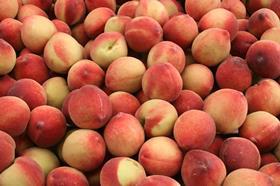
Price is a constant bone of contention in the fresh produce industry and in Spain frustrations bubbled over last week when stonefruit growers denounced European retailers for not passing on low prices to the consumer.
The price paid to the grower for early season fruit has crashed due to overproduction, but supermarkets across the continent have continued to charge comparatively high prices.
Data published by COAG, the body that represents agricultural and livestock unions in Spain, revealed that producers were paid an average of €0.50 per kg of peaches and nectarines during May, while the average sale price was seven times higher at €3.50.
Abnormally hot weather has forced many to harvest their fruit early in order to preserve its condition in coldstores, and high temperatures look set to cause a glut. According to estimates in May, the major production regions of Murcia and Catalonia will both see large increases in yield, with Murcian nectarine and flat peach volumes expected to rise by 30 per cent.
“In general, we have experienced very favourable conditions in all areas where stonefruit is grown,” says CPM Retail senior procurement manager Jasmine Monteil. “We have not experienced any supply issues and frost in Europe [in late April] did not have any major impact on our fruit.”
Despite the consequent abundance of early product, Total Produce’s Charlie Hicks says he has his usual concerns about the quality of early-season varieties. “We feel that you have to get two or three varieties in before you get to the best-tasting fruit,” he says – particularly in apricots. “What worries us is that our chef customers taste the early varieties – which are obviously a bit more expensive – and it puts them off for the rest of the year.”
In the UK, one explanation for the gulf in price paid to the producer and by the end consumer is the rising cost of fresh produce imports since the Brexit referendum.
“The post-Brexit exchange rate is working against us,” says Hicks. “That’s going to keep prices firmer than they would normally be, we think, through the season.”
Hicks believes stonefruit has been “too cheap for too long”, but now a combination of factors, including the exchange rate, a proliferation of new stonefruit markets and the Brexit vote are driving up wholesale prices. “I think growers are looking at Britain in a way they weren’t previously,” he says. “They’re perhaps not quite so keen to sell to us as they were.”
All the more reason, perhaps, for the UK to develop its own stonefruit production, with Hicks heaping praise on Herefordshire grower Oakchurch Farm for its apricots and other stonefruit. Strong progress has been made in apricot fruit quality in recent years, with food writer Nigel Slater commenting on the marked improvement “even in supermarkets” in a 2015 Observer article.
Despite this, apricots still account for only a small part of the stonefruit category, with plums and nectarines continuing to represent the greatest portion of stonefruit retail volumes, according to Chingford Fruit. Across the category as a whole, value sales have declined by 5.8 per cent, with a fall in trip volume the main culprit, accounting for £26m in losses.
In cherries, which have suffered the biggest sales slide, availability has been limited in both the UK and overseas, according to Berry Gardens new chief executive Jacqui Green. “In the UK we suffered a frost around blossom time, and Turkey and Greece were hit by frosts earlier in the year,” she says.



